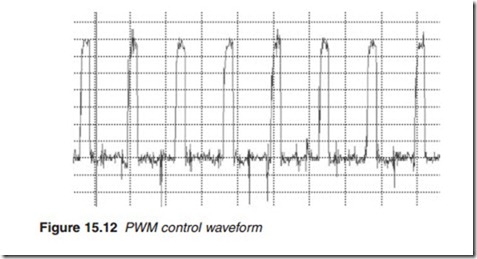Self-oscillating power supply
The functions of regulator and oscillator may be combined in a single transistor to form a self-oscillating power supply (SOPS). The simplest arrangement is that shown in Figure 15.14 in which a secondary winding of the isolating transformer is used as a part of a blocking oscillator. At switch-on the switching transistor TR1 begins to conduct as a result of the forward-bias applied to its base via start-up resistor R1. The collector current increases, which induces a positive voltage across secondary winding S2. This forward biases D1 and further increases TR1 current. When saturation is reached, the increase in current ceases and a negative voltage is induced across S2 to reverse-bias D1, switching off TR1. At this point, the voltage across primary winding P1 reverses and D2 switches on. The tuned circuit formed by primary winding P1 and C1 begins to oscillate, transferring energy from P1 to C1. For the second half of the cycle, when energy begins to transfer back to P1, diode D2 is reverse-biased, oscillations stop and the current in P1 reverses; this causes a positive voltage to be induced across S1, turning TR1 on, and so on. Trigger pulses from a control circuit are used to initiate each cycle to keep the d.c. output constant.
A self-oscillating SMPS circuit based on a Panasonic chassis is shown in Figure 15.15, in which TR3 is the chopper/oscillator transistor and C9 is the blocking capacitor, which discharges through transistor TR2. Pulses derived from the line output stage are fed to the base of TR3, via isolating
transformer T2, to turn on TR3 just before its natural turning off point. Regulation is obtained by controlling the conduction of TR2 and thus the discharge of C9. Transistor TR2 is itself controlled by TR1, which senses any change in the voltage developed across C8 caused by changes in the loading of the isolating transformer as well as changes in the mains input. The voltage across feedback winding S1 is rectified by D7. The negative voltage thus produced is used to charge C8 to provide a measure of the loading of the transformer. This voltage is then used to provide TR1 emit- ter voltage via zener D6. Changes in the loading of the transformer, whether caused by changes in the load current or in the mains voltage, cause the voltage at the emitter of TR1 to change, which determines the base bias of TR2, hence the discharging current of C9. The current through TR1 may also be varied by the ‘set’ control R2. TR4 provides a degree of protection against excessive current taken by TR3. A large current through R11 will cause TR4 to conduct, taking TR3 base to chassis via diode D5. Further protection is provided by D10 and D11 on the secondary side of the circuit. Transformer T2 provides mains isolation.
Resonant converters
Increased demands for increased power and improve efficiency coupled with stringent electromagnetic interference (EMI) interference levels brought a well-known technology in the field of electric motors and other high-power devices, namely the resonant converter to be used in television receivers. Resonant converters will be discussed in detail in the following chapter.

